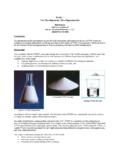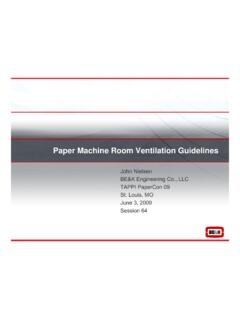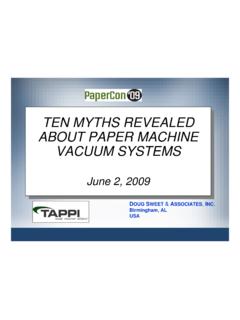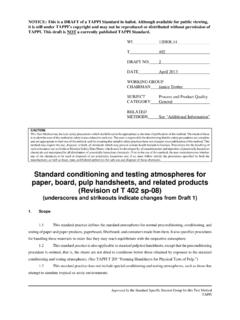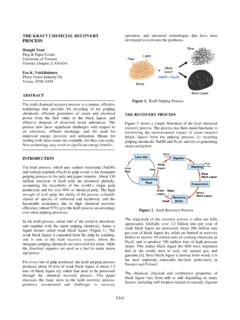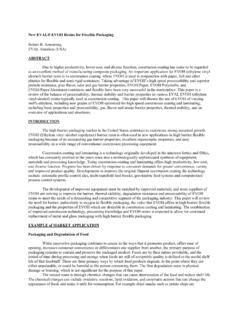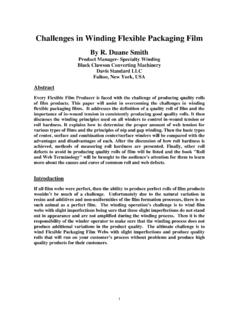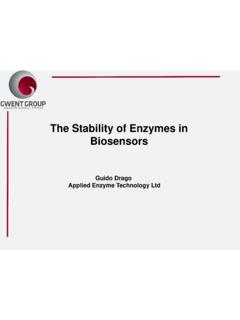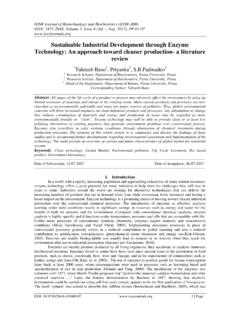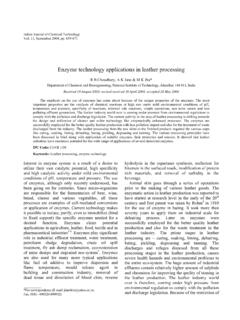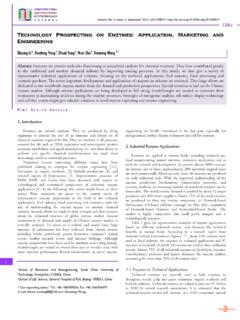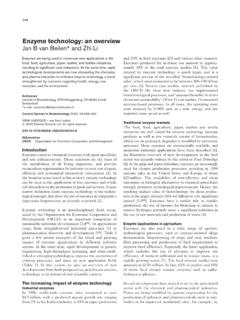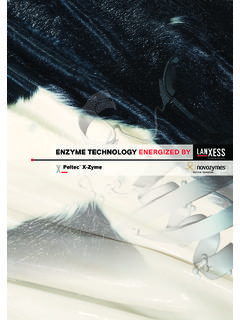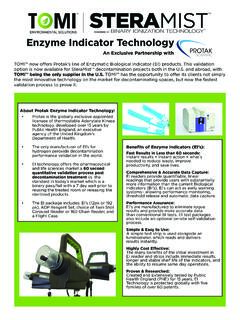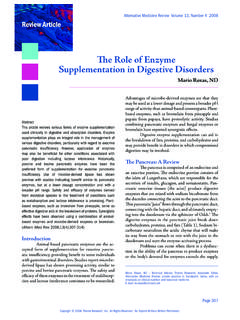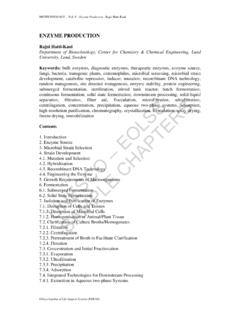Transcription of Green Technology: Last Developments in Enzymes for Paper ...
1 Green technology : Last Developments in Enzymes for Paper Recycling Juan C. Cotrino and Victor Ordonez VH BIOTECHNOLOGY, Inc. ABSTRACT Application of Sustainable development policies implies the application of Green processes that reduce waste and pollution by changing patterns of production. Green processes are based on innovative ideas that generate alternatives to those technologies that can negatively affect the environment. Today, enzyme-catalyzed processes are gradually replacing chemical processes in many areas of industry because they save energy, water and chemicals, help to improve product quality, and furthermore they also give valuable environmental benefits. Actually, the pulp and Paper industry faces several problems such as a global pressure to reduce water consumption, to use more recycled fiber and to lower environmental impacts.
2 From that point of view, the development of papermaking processes with low environmental impact finds in the use of Enzymes a suitable option, especially when Paper recycling is considered. Most operations of re-pulping, cleaning and processing secondary fibers involve the use of large quantities of chemical products, which makes the technology expensive and highly environmentally damaging. Innovative ideas in enzyme production allow the commercial use of a Green enzymatic biocide that replaces standard biocides in pulp & Paper mills without negative effects on plant workers or the environment; a wide spectrum sterolytic product that eliminates the drawbacks caused by the very complex problem of stickies; an enzyme product that hydrolyze wet strength resins in recycling processes at Paper mills and finally, a very complex enzyme formulation designed to clean and deink tissue furnish formulations containing mixed office waste, old magazines, old newsprints, box board cuttings and colored ledgers.
3 This Paper presents data obtained at tissue mills using those innovative enzyme products. INTRODUCTION In recent years, the concept of sustainable development has acquired important political and social attention. An important aspect of sustainable development corresponds to the application of Green technologies and use of Green products which contribute to sustainability by reducing environmental degradation, providing better ways of doing things while reducing impacts, and contributing to the "greening" of the society (1). From the above point of view, biotechnology refers to the use of microorganisms (for example bacteria) or biological substances (for example Enzymes ) to develop new products of industrial, agricultural or therapeutic interest in order to improve the quality of human life.
4 Today, Enzymes are used for an increasing range of applications. In fact, enzyme-catalyzed processes are gradually replacing chemical processes in many areas of industry because they save energy, water and chemicals, help to improve product quality, and furthermore they also give valuable environmental benefits. These benefits are becoming more and more important at a time of increasing awareness about sustainable development , Green chemistry, climate change and organic production. Regarding the pulp & Paper industry, the reduction in water consumption, the closure of water loops, the increased use of recycled fiber, the low quality of furnishes and the manufacture under alkaline/neutral conditions have considerably increased the problems of deposit formation, corrosion and odors in the papermaking process, thus affecting the productiveness of the Paper machine, the life of the equipment and the quality of the final product (2).
5 Deposits within the Paper industry can be separated into two main groups: non-biological (stickies, pitch and scale) and biological (slime), although both forms are often combined. Various enzyme products obtained by means of microbial fermentations are helping recycling Paper mills to overcome the actual adverse circumstances that affect efficiency and productiveness of their Paper machines. In fact, enzyme products are being innovated for slime control, for stickies control, for hydrolysis of wet strength resins and for deinking complex tissue formulations. PaperCon 2011 Page 1630 development OF A Green ENZYMATIC BIOCIDE It has been estimated that under some circumstances, slime deposits can be responsible for up to 70% of all breaks, blockages and pump failures in pulp & papers mills (3).
6 Biocides are routinely used for slime deposit control in Paper mills. They are directed against living organisms, but frequently not restricted to target organisms . This implies that they inevitably also can harm the health of non-target organisms such as humans or animals. Biocides contain highly hazardous substances which are potentially harmful for the skin, can cause cancer or damage the DNA, the reproductive or immune system. They can also have endocrine disrupting effects, impairing hormonal system with long-lasting harmful consequences (4-9). Due to their hazardous properties, standard biocides are highly regulated substances worldwide. The regulatory considerations are having a profound effect for the pulp & Paper industry, most notably in the United States, Canada and Western Europe.
7 The United States Protection Agency s (EPA) product registration process is costly and time consuming. The Canadian process is comparable to that in the United States. The European Union's Biocidal Products Directive went into effect in 2000 and will eventually remove a large number of products from the market if they do not pass regulatory round-up, or producers decide to not submit them for approval. In developing regions, regulatory climates vary widely. In several countries, regulations concerning biocide use are beginning to resemble those in the US, Canada, Japan and Western Europe (10, 11). Alternative methods to conventional biocides are being investigated for slime control. One approach is the use of specific Enzymes to prevent biofilm formation or to degrade existing biofilms.
8 For example, the US Patent No. 4370199 (12) proponed a method of killing and inhibiting the growth of microorganisms in industrial process streams by the addition of a microbial or plant dehydrogenase enzyme such as peroxidase or laccase in the presence of an oxidant. Other researchers (13, 14) were investigating Enzymes for hydrolysis of the polysaccharides produced by bacteria in slime films. A new biocide based on cell wall lytic enzyme activities was developed. In the field of microbiology, it is well known that some microorganisms are able to produce cell wall lytic Enzymes that affect bacterial, fungal and yeast cells such as exo- -1,3-glucanases, chitinases and proteases (15-19). The enzymatic Green biocide presents following characteristics and advantages: It is a biodegradable product that does not pose any risk to mill workers or to the environment.
9 It is non-volatile, non-reactive and is stable during transportation. Totally replaces standard chemical biocides at Paper mills. It shows bacteriostatic and bactericidal properties. It is active against gram-positive and gram-negative bacteria. It has residual effect; it can be applied by shock loads. Does not allow bacterial strains to create microbial resistance. It eliminates biological slime in piping and equipment doing a permanent boil-out. Reduces Paper breaks at the PM and increases stability of the PM. Allows closure of mill water circuits without increasing water corrosivity. Reduces bad odors in the water circuits and final products. Following cases show the results of applying the new enzymatic biocide at pulp & Paper mills: CASE 1. Bacterial control at a tissue Paper mill starting the use of the enzymatic biocide.
10 DAY BACTERIAL COUNT AT WIRE PIT 0 60 millions CFU/g 5 15 millions CFU/g 10 4 - 5 millions CFU/g PaperCon 2011 Page 1631 CASE 2. Downtime reduction due to elimination of dirt and slime detachment at enzymatic biocide at a OCC mill: A Downtime reduction due to elimination of dirt detachmentReduction from 5,6 h/day to 0,4 h/day on PM 1 (Reduction 93 %)Reduction from 2,7 h/day to 0,2 h/day on PM 2 (Reduction 92 %) B Downtime reduction due to elimination of slime detachmentReduction from 0,5 h/day to 0,1 h/day on PM 1 (Reduction 74 Reduction from 0,8 hr/day to 0,3 hr/day on PM 2 (Reduction 70 %) CASE 3. Bacterial counts at the wire pit in a tissue mill using the enzymatic b CASE 4. Bacterial count at the machine chest of a x 106 Graph 1: Monthly average values of Total Bacterial Count at the wire pit in a tissue mill using the enzymatic biocide.)
